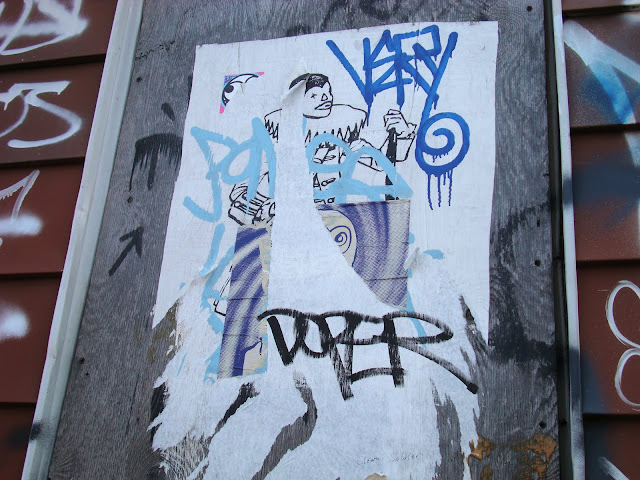One of the things I love about graffiti and street art is that it is unexpected. It's surprising to walk down the street, or peer into an abandoned lot, and suddenly there's a piece of unsolicited "public art" that was not there the week before, or even the day before. In its many forms, street art changes the scenery in an otherwise uneventful urban landscape for an undetermined and temporary amount of time. It can also just appear out of nowhere dominating an overly-advertised locale that otherwise doubles as a visual assault for passers-by. In either case, street art and graffiti is ephemeral. It doesn't last. Someone else will invariably come along and add to the piece or completely cover it resulting in a layered collage or colorful pastiche that makes up our fair city. Or the supporting structure is knocked down to make way for so-called development. For these reasons, I have been documenting painted trains, elevated tracks, and the art of the streets since I was a teenager in Philadelphia.
Another thing I like about street art is that it has an in-your-face aspect to it. It's there whether you like it or not. It's there without begging a gallery dealer to review your slides. It's there because the artist chose a place, and wanted it to be there. The power no longer lies in someone else's hands, but is just taken. The power now lies with the artist turning the customary protocol of the art world on its head. And, those seemingly impenetrable art galleries are starting to take notice and embrace street culture.
Over the past year, I've seen (and of course, documented) a certain clown figure appearing on the walls of Manhattan, Brooklyn, and Long Island City. Back in March, when the art fairs came into New York, I happily and almost quite literally bumped into an artist who was carrying an armload of prints of the same clown that I had seen about town; one of my favorite characters that repeatedly pops up around the city. This artist is
Clown Soldier, and I have had the chance to ask this artist/master printer a few questions about the paste-up process, its origins, and the art itself. The art of Clown Soldier is colorful. It also possesses a regal quality and simultaneously makes me laugh. There's something about this larger-than-life-sized figure that makes me stop and really take notice of the space around me.
______________________
\klaün\ \sōl-jər\
As defined in the artist's own words, Clown Soldier is a comic performer, as in a circus, theatrical production, or the like, one who wears an outlandish costume and makeup and entertains by pantomiming common situations or actions in exaggerated or ridiculous fashion, by juggling or tumbling, etc. Clown Soldier is a person who acts like a clown, a comedian; a joker, a buffoon, a jester. Clown Soldier is a prankster, a practical joker.
Who is the clown figure? Does he represent anything specific? What is your message?
I don’t have a message. I think contrived messages that aren’t sincere should be abolished. I don’t know who the clown figure is. It’s up to the viewer to decide. He doesn’t represent anything specific.
When I saw you, I recognized the clown figure immediately, and didn’t realize that you also do prints. Were you a printer or street artist first? Which lifestyle/artform do you feel more drawn or dedicated to?
I was a printer first. Actually, I was a painter first. I don’t draw a line between one lifestyle or another. I morph in and out of being one thing from day to day minute by minute. I usually wind up becoming an artist of some type. Right now, I find street art very exciting. I hope to stay with it for some time. I also find collage, painting, print making, web design, thinking, and many other things enjoyable.
A colorful panorama on a rusted-out wall in Long Island City, Queens
A closeup of the Long Island City wall
Regarding the piece with the billboard tiger, the tiger was originally printed for an exhibition celebrating the "Year of the Tiger" which is this current year within the Chinese lunar calendar. It is a 3-color CMYK halftone dot print where only the CMY is printed in transparent based process colors to allow for the blending of more than one color. The piece in real life really vibrates and from close up, it is hard to read the image. It looks more like a cluster colored patterns of dots that looks a little psychedelic. The viewer has to stand 5-10 feet away to see the full image of the tiger. When the image is photographed, it does not read well in reproduction and just comes across as a flat image of a tiger. The intended effect is lost.
Meatpacking District of lower Manhattan (with MBW, Gaia, Elbow Toe, and others)
Closeup with Gaia (photo used with permission by Gaia)
Your work seems to have a colonial vibe to it. Is the clown figure rooted in early American history? Is this figure politically-based?
No, the clown figure is French 18th century. This was the style for the time. I do not choose my images based on its political message. My decisions are based on more formal aesthetic decisions. They are based on their line form and color.
Long Island City with a bird in flight by Yote (photo used with permission by Gaia)
You have developed other figures that are composed of blended parts. Please describe some of your other work and process.
I am interested in hearing the conclusions that other people arrive at when they see it. I can say that people in general feel that the work is whimsical and there is a sense of humor that comes across...something that is lacking in a lot of art work but seems to be more prevalent in street art in general.
A figure appearing in two places in Williamsburg
(left) Mouse with Legs and Two Storks (photos used with permission by Clown Soldier) and
(right) a utopian paste-up in Williamsburg
How long do your paste-ups generally last? Why did you choose this method vs. traditional aerosol? Have you ever worked with aerosol? I just started pasting a year ago so I don’t know how long they last. The first piece I put up a year ago is still up. I have been sharing a studio with a lot of street artists. They have influenced what I do immensely. In the past year I have shared a studio with Imminent Disaster, Swoon’s project manager and printing team, and Gaia. They are all really great people and have inspired me a great deal. Gaia is the one who showed me the ropes as far as getting up. He is amazing, very cool, talented, and funny too.
Clown Soldier with Gaia under the Hi-Line in Chelsea (photo used with permission by Gaia)
When did you know you wanted to be an artist? What was your work like when you first started? What compelled you to take it to the streets?
I started drawing from when I was a toddler. My mother caught me and my brother drawing all over her walls after we had gotten into her mascara cabinet. The first pieces we did were very scribbly. My work was very scribbly doodlish when I started. I think my work still looks like doodles. I’m a doodler. I enjoy doodling.
Clown Soldier with Gaia in Williamsburg
Do you think street art has become too mainstream, decorative, and interior design-y?Do you think it has lost its message and edge since the 70’s and 80’s? Has it lost its edge? I suppose so....this seems like some kind of projection....is this how you feel? I hope you don’t mind me asking. I suppose I can see your point. It's not bubbly anymore.
A new Clown Soldier over an older piece in Williamsburg
Do you think anonymity is necessary for doing “public works”? Have you ever gotten into any trouble with the cops?
It is only necessary because it is illegal and pisses a lot of people off. I try not to get up on anyone’s property. I understand that people own property and they get fined if the building is graffitied. I try to hit abandoned places that have already been hit. I have had several run-ins with the police. The first time I went out was in Bushwick. I had no idea what I was doing.
A new piece with Army of One in the Meatpacking District (June, 2010)
Have you ever pasted anything up in another region or country besides NYC?
Yes in Austin, Texas during SXSW.
Austin, Texas (photo used with permission by Clown Soldier)
Who are you influenced by/ favorite artists from both the art world and the street realm?
Jean Dubeffet, Andy Warhol, Robert Rauschenberg, Max Ernst, Pablo Picasso, Banksy, Gaia, Swoon, Barry Mcgee, Chris Johanson, Tim Hawkinson, and many others.
Urban textures - remnants of a small paste-up in Bushwick, Brooklyn
Where do you like to go for inspiration?
Museums, parks, the streets, gardens, mountains, nature, bookstores, children’s books, encyclopedias, junk shops.
Poster for Leo Kesting Show (next to an altered MBW) - Meatpacking District, Manhattan
Do you have any big projects or exhibitions coming up for 2010 and 2011?
Yes, I am showing in Atlanta, Georgia with Swampy, Gaia, Know Hope, and many others at the
Living Walls Conference.
My work is also in the exhibition called Dead Letter Playground at the Leo Kesting Gallery opening this week in Chelsea with other street artists. I only have one piece in this exhibition: it is of a soldier with a butterfly wing that acts as a cape for the soldier. It is titled, "Monarchy". The soldier has an assured stance moving forward but is looking to the right with an unsure questioning expression. For lack of better words, the juxtaposition of the butterfly wing and the soldier works both as oxymoron while I find there are some similarities that can be drawn. The obvious connotations can be drawn- a butterfly is such a peaceful image, and of course, a soldier represents the opposite. The butterfly wing works so perfectly in this case as the soldier's cape. A butterfly has been through a metamorphosis just as a soldier has to go through a kind of existential metamorphosis; to become a soldier one has to go from being a civilian to becoming a trained killer. I also think it's interesting that the butterfly wing is of the Monarch type which leads to more interpretive possibilities. All these conclusions come after the image was already created. This is what I like about my work; it comes together naturally and does not look contrived. The overall meaning arrives later when the intention and my thoughts and sense of humor are all arrived at simultaneously.
Dead Letter Playground - A Collection of Contemporary Street Art at the Leo Kesting Gallery (June 24 - July 18, 2010)
.jpg)
.jpg)
.jpg)

.jpg)
.jpg)

.jpg)
.jpg)


.jpg)
.jpg)
.jpg)

.jpg)

.jpg)




+cropped.jpg)




.jpg)
.jpg)


.jpg)



.jpg)













.jpg)






.jpg)
.jpg)



